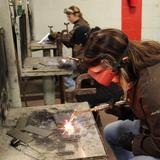- Students are often surprised at what they find at Herzing University: An individualized approach to exploring their career choice in gaining admission to the University; small classes where instructors and staff know their names; demanding and confidence-building coursework; and people that truly care about their success. It probably comes as no surprise that Herzing students build strong and lasting bonds with their teachers and fellow classmates by the end of their programs at Herzing. Located in the northwest suburbs of the Twin Cities, the Minneapolis Campus has prepared students for dynamic careers in technology, business and the growing field of healthcare. Year in and year out, our graduates have exceeded the expectations of employers in the area and throughout the U.S. Our focused degree programs concentrate on skills necessary to succeed every day in the fields of technology, business, and healthcare.
- Herzing University joined forces with two Minneapolis schools to form the Herzing University Minneapolis campus. The Minneapolis Drafting School Division was acquired in 2000, after nearly 40 years of serving the Minneapolis area. In 2002, the Lakeland Medical Dental Academy became a part of the Herzing University School system, making it what it is today. Herzing University offers programs in business, design, public safety, technology, and healthcare. The drafting and design program has gained a reputation for producing some of the top drafters in the Twin Cities and surrounding areas.
School Highlights
Herzing University-Minneapolis serves 1,209 students (39% of students are full-time).
The college's student-teacher ratio of 21:1 is lower than the state community college average of 22:1.
Minority enrollment is 56% of the student body (majority Black), which is more than the state average of 42%.
Quick Facts (2025-26)
- Enrollment: 1,209 students
- Private-state tuition: $14,200
- Acceptance Rate: 94%
- Student-teacher ratio: 21:1
- Minority enrollment: 56%
- Source: Integrated Postsecondary Education Data System (IPEDS)
Top Rankings
Herzing University-Minneapolis ranks among the top 20% of public schools in Minnesota for:
Category
Attribute
Diversity
School Resources
School Overview
The teacher population of 57 teachers has stayed relatively flat over five years.
Herzing University-Minneapolis
(MN) Community College Avg.
Carnegie Classification
Special Focus Four-Year: Other Health Professions Schools
Associate's Colleges: Mixed Transfer/Career & Technical-Mixed Traditional/Nontraditional
Institution Level
Four or more years
At least 2 but less than 4 years
Institution Control
Private not-for-profit
Public
Total Faculty
57 staff
171 staff
School Calendar
Student Body
The student population of Herzing University-Minneapolis has grown by 134% over five years.
The student-teacher ratio of 21:1 has increased from 11:1 over five years.
The Herzing University-Minneapolis diversity score of 0.71 is more than the state average of 0.63. The school's diversity has stayed relatively flat over five years.
Total Enrollment
1,209 students
2,858 students
Student-Teacher Ratio
21:1
22:1
# Full-Time Students
476 students
1,050 students
# Part-Time Students
733 students
1,808 students
# Enrollment Undergraduate
119 students
420 students
# Full-Time Undergraduate Students
464 students
915 students
# Full-Time Graduate Students
12 students
38 students
# Part-Time Undergraduate Students
732 students
1,771 students
# Part-Time Graduate Students
1 students
12 students
Total Dormitory Capacity
n/a
116 students
% American Indian/Alaskan
n/a
1%
% Asian
11%
6%
% Hispanic
7%
8%
% Black
28%
15%
% White
44%
58%
% Hawaiian
n/a
1%
% Two or more races
4%
4%
% Non Resident races
n/a
1%
% Unknown races
6%
6%
Diversity Score
0.71
0.63
College Completion Rate (Students who graduate in less than 4 years)
n/a
34%
College Completion Rate (Students who graduate in 4 years or more than 4 years)
71%
57%
Average Graduate Earnings (10 Years)
$45,100
$36,900
Tuition and Acceptance Rate
The private state tuition of $14,200 is less than the state average of $17,300. The private state tuition has stayed relatively flat over four years.
Private State Tuition Fees
$14,200
$17,300
% Students Receiving Some Financial Aid
100%
89%
Median Debt for Graduates
$22,052
$12,264
Median Debt for Dropouts
$6,747
$6,750
Acceptance Rate
94%
94%
SAT Reading
n/a
625
SAT Math
n/a
600
SAT Writing
n/a
565
ACT Composite
n/a
24
ACT English
n/a
24
ACT Math
n/a
23
ACT Writing
n/a
8
Source: 2024 (or latest year available) Integrated Postsecondary Education Data System (IPEDS)
School Notes
- Herzing University operates according to its motto: Career-focused, convenient, and caring. They are a university committed to giving their students convenient education options so they are able to get a quality degree without sacrificing in other areas of their lives. They put their students first by offering one-on-one guidance throughout their time at the university and career guidance after they graduate. Herzing University is accredited by The Higher Learning Commission and is a member of the North Central Association (www.ncahlc.org, 800-621-7440).
Frequently Asked Questions
How much does Herzing University-Minneapolis cost?
Herzing University-Minneapolis's private state tuition is approximately $14,200.
What is the acceptance rate of Herzing University-Minneapolis?
The acceptance rate of Herzing University-Minneapolis is 94%, which is equal to the state average of 94%.
What is Herzing University-Minneapolis's ranking?
Herzing University-Minneapolis ranks among the top 20% of community college in Minnesota for: Diversity in US community colleges and Percent of students receiving financial aid.
In what neighborhood is Herzing University-Minneapolis located?
Herzing University-Minneapolis is located in the Shelard Park neighborhood of St. Louis Park, MN.
Recent Articles

The Rise of Technical and Vocational Training in 2025
Explore the 2025 surge in technical and vocational training—enrollment, policy, costs, and why this path is gaining ground for students and parents.

Stackable Credentials: How Community Colleges Advance Careers
Discover how community colleges use stackable credentials to build career pathways, boost earnings, and enable lifelong learning in 2025.

High-Paying Jobs You Can Get with a Community College Degree
Discover top high-paying careers you can launch in 2025 with a community college (associate) degree and high-growth credentials in tech, healthcare and trades.









